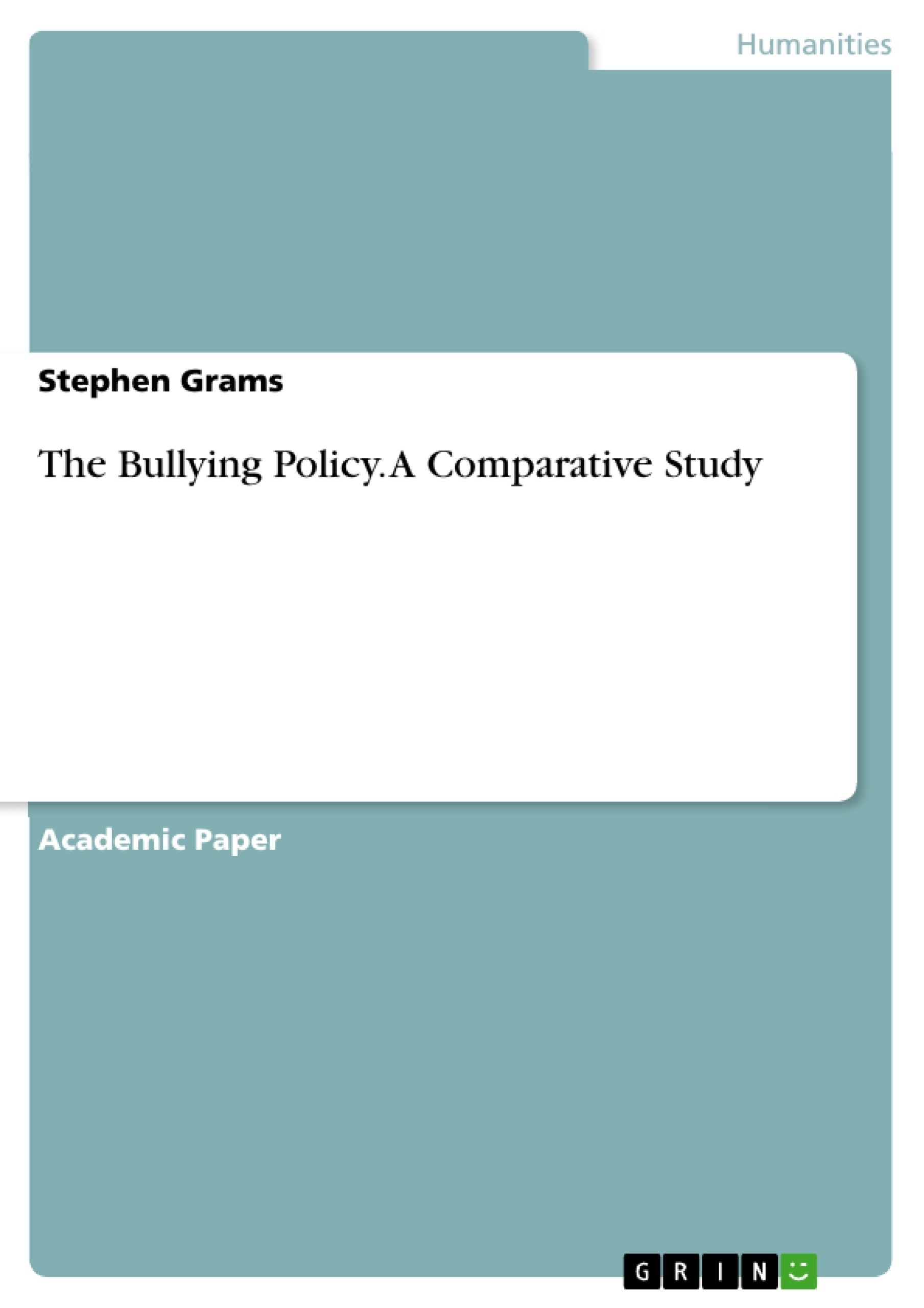Excerpt
Introduction
Bullying is defined by the Wis. Dept. of Public Instruction as behavior that is aggressive, not wanted, and occurring in conjunction with school age students. Bullying/harassment is caused by non-harmonious perception or realization of power. Bullying is often repetitive and may cause “serious, lasting problems” (A comprehensive approach to bullying prevention, Retrieved from:{ HYPERLINK https://dpi.wi.gov/sspw/safe-schools/bullying-prevention" }. “These behaviors are normative occurrences in schools, they are not considered socially acceptable in the context of democratic societies” (United Nations, 1989). I posit, bullying/harassment, may occur as a result of the intent to control another person’s behavior, attitudes, beliefs, and culture in general, for the acquisition of resources and the resultant power to achieve a goal that is not entirely ethical.
Looking back, as a child, I can affirm the imbalance of power part of the definition leading to bullying which could possibly be validated through my own second grade behavior and need for control. My favorite show was Combat with Vic Morrow. My favorite books were about Kit Carson, Jim Bridger, and Daniel Boone. I resolved feelings of powerlessness over my life in the sense of its lack of stability and dealt with imbalances in power through wrestling with other students during recess and after school. Although not totally responsible or at fault, TV war shows and tales in books of killing Indians were a major part of my life and made it seem OK somehow to resolve problems by fighting.
Wisconsin’s model bullying policy
Bullying in the school system has been happening for a long time. In Wisconsin, schools had to “adopt bullying policies” by August 25, 2010 (2009 Wisconsin Act 309 (SENATE BILL 154) ({ HYPERLINK "https://docs.legis.wisconsin.gov/2009/related/acts/309" }). Before that the Wisconsin Government Statute, 118.46 policy on bullying, March 1, 2010 was to be developed. Electronic bullying and off-campus bullying were not considered to be a part of bullying.
The Wisconsin Model Policy now includes cyberbullying (Bullying laws in Wisconsin: { HYPERLINK "https://cyberbullying.org/bullying-laws/wisconsin" }). A Dr. Patchin proposed an update to the law in 2013 (Bullying in Wisconsin, Retrieved from: { HYPERLINK "https://cyberbullying.org/wisconsin_bullying_law_2013_sentate_bill_184"}). Abuse of the law deemed consequences and has legal implications (Bullying in Wisconsin, et.al).
The Wisconsin Model Bullying Policy key district policy components include: 1.) Definitions; 2.) Reporting; 3.) Investigations; 4.) Written record; 5.) Consequences; 6.) Mental health. Key components are concerned with: 1. Purpose; 2.) Scope; 3.) Prohibited behavior; 4.) Enumerated groups. There are additional components of: 1.) Communications; 2.) Training/prevention; 3.) Transparency/monitoring; 4.) Legal remedies (Wisconsin anti-bullying laws and policies Retrieved from: { HYPERLINK "https://www.stop bullying.gov./laws/wisconsin/inddx/html" }).
Policy language
The policy language at Middleton High School (MHS), in the District where I work in my vocation as a substitute teacher/special ed para, as an on-call employee in the educational business entity of the field of education, has similar bullying policy to the Walton County School District (WCSD) in Florida. Both are developed from State Statutes and Laws. Wisconsin has two Statutes concerning bullying that I could find: 1.) 118.46, policy on bullying/harassment; 2.) 948.51- policy on hazing. Florida, the state where the sample Walton School District is located, also has two statutes:1.) 1001.41; 2.) 1001.42. Florida has nine laws concerning bullying/harassment: 1.) 1001.43; 2.) 1003.04; 3.) 1003.31; 4.) 1003.32; 5.) 1006. 7; 6.) 1006.8; 7.) 1006.8; 8.) 1006.9; 9.) 1006.147 (Walton-policy-5-301, pdf., p.12, Retrieved from: { HYPERLINK "https://blackboard.cuchicago.edu/)" }.
A difference I did note, regarding definition, stems from my construct about relatedness of the word environment to bullying. Definition of the word stemming from environmental history reading of Wisconsin which includes works and philosophies of environmentalists’ such as Aldo Leopold, Sigurd Olson, and John Muir. In the MHS dialogue concerning bullying, reference is made to adverse effects on the environment of the school relating to bullying, while the WCSD discussion of environment is stated as “social climate and norms.” The words social climate and social norms, although an adequate description of environment, do not express the total meaning of the word. The word “environment,” encompasses more than social climate and social norms when considering the relation to habitat, and ecology, which basically means “house, or home,” What is missing is the fulfillment of human needs of identity, meaning, and security inherent in the word home. “Be it ever so humble there is no place like home” (Payne, 1823). The policy statement “no disruption to learning environment” carries more weight, linguistic connotation, and inclusivity with the realities of being (Student bullying reporting, Retrieved from: https://www.publicschoolworks.com/SHL/bullyingMgr.asp?di=793&dia=mszmy).
Procedural steps and reporting components
When considering the procedural steps and reporting components outlined in the policy samples and how it matches or does not match with the organization (MHS), there is an investigative procedure for reporting acts of bullying. (Stop bullying hotline, Retrieved from: { HYPERLINK https://www.publicschoolworks.com/SHL/bullyingInfo.php?di=793&dia=mszmy" }). At MHS- incidents are reported through Public School Works Reporting System online at (Public school works, Retrieved from, { HYPERLINK https://www.publicschoolworks.com/SHL/bullyingReport.php?di=793&dia=mszmy" }).
Incidents are also reported by telephone, the web address given on the MHS website for reporting by telephone given is: (Public school works, Middleton-Cross Plains Area School District https://www.publicschoolworks.com/SHL/bullyingInfo.php?di=793&dia=mszmy).
MHS and WCSD are about the same in consideration of the number of possible bullying scenarios in the bullying anti-harassment policy language samples to be reported. There are a possible 11 events labelled as concerns at MHS websites paragraph on bullying policy, whereas there are 10 topics and/or concerns listed in Section X, subpart B. of the WCSD policy involving harassment and bullying ({ HYPERLINK "https://blackboard.cuchicago.edu/bbcswebdav/pid-3446513-dt-content-rid-18607959_2/xid-18607959_2" \t "_blank" }), p.12, et.al.).
[...]
- Quote paper
- Stephen Grams (Author), 2019, The Bullying Policy. A Comparative Study, Munich, GRIN Verlag, https://www.grin.com/document/454950
Publish now - it's free






















Comments